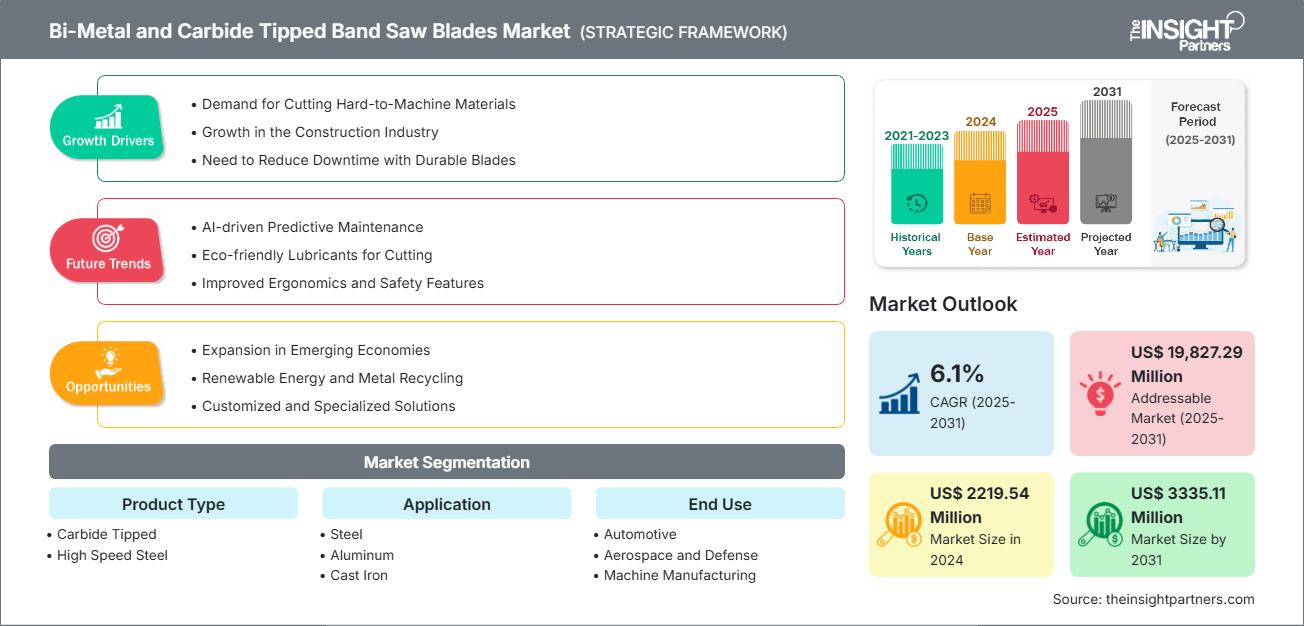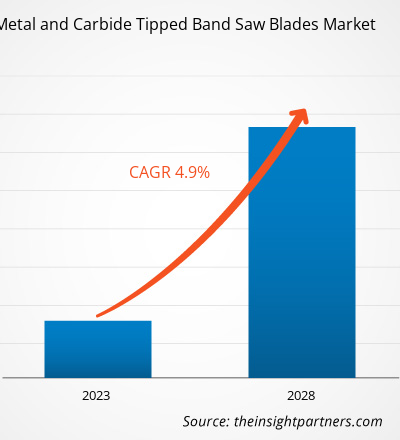Der Markt für Bimetall- und Hartmetall-bestückte Bandsägeblätter wird Prognosen zufolge bis 2031 ein Volumen von 3335,11 Millionen US-Dollar erreichen, gegenüber 2219,54 Millionen US-Dollar im Jahr 2024. Es wird erwartet, dass der Markt im Zeitraum 2025–2031 eine durchschnittliche jährliche Wachstumsrate (CAGR) von 6,1 % verzeichnen wird.
Marktanalyse für Bimetall- und Hartmetall-bestückte Bandsägeblätter
Der Markt für Bimetall- und Hartmetall-bestückte Bandsägeblätter wird von mehreren Schlüsselfaktoren angetrieben, die gemeinsam sein starkes Wachstum begünstigen. Die zunehmende Automatisierung in Fertigungsprozessen sowie die steigende Nachfrage nach hochpräzisen Schneidlösungen in verschiedenen Branchen wie der Automobil- und Luftfahrtindustrie tragen maßgeblich zur Marktexpansion bei. Darüber hinaus haben technologische Fortschritte die Leistung der Sägeblätter durch die Entwicklung langlebiger, verschleißfester Materialien und fortschrittlicher Beschichtungstechnologien wie Titannitrid verbessert. Dies erhöht die Schnittleistung, verlängert die Standzeit der Sägeblätter und senkt die Betriebskosten.
Marktübersicht für Bimetall- und Hartmetall-bestückte Bandsägeblätter
Bimetall-Bandsägeblätter sind Hochleistungsschneidwerkzeuge, die aus einer flexiblen Schneide aus Schnellarbeitsstahl und einem robusten Träger aus kohlenstoffarmem Stahl bestehen. Diese Kombination verleiht dem Sägeblatt eine ausgezeichnete Härte und Verschleißfestigkeit an der Schneide bei gleichzeitiger Flexibilität und Langlebigkeit. Dadurch eignet es sich ideal zum präzisen und dauerhaften Schneiden einer Vielzahl von Metallen. Hartmetallbestückte Bandsägeblätter hingegen verfügen über Schneidzähne mit Hartmetallbestückung – einem sehr harten und verschleißfesten Material –, die auf einem Stahlträger befestigt sind. Diese Sägeblätter eignen sich besonders zum Schneiden extrem harter oder abrasiver Materialien wie Gusseisen, Edelstahl und Nichteisenmetalle.
Sie erhalten eine kostenlose Anpassung aller Berichte – einschließlich Teilen dieses Berichts, Länderanalysen und Excel-Datenpaketen – sowie attraktive Angebote und Rabatte für Start-ups und Universitäten.
Markt für Bimetall- und Hartmetall-bestückte Bandsägeblätter: Strategische Einblicke

-
Ermitteln Sie die wichtigsten Markttrends dieses Berichts.Diese KOSTENLOSE Probe beinhaltet eine Datenanalyse, die von Markttrends bis hin zu Schätzungen und Prognosen reicht.
Markt und Chancen für Bimetall- und Hartmetall-bestückte Bandsägeblätter
Markttreiber:
- Steigende Nachfrage nach der Bearbeitung schwer zerspanbarer Werkstoffe: Die Nachfrage nach der Bearbeitung schwer zerspanbarer Werkstoffe wie Titan, Edelstahl, Nickelbasis-Superlegierungen und anderer Spezialmetalle nimmt deutlich zu. Diese Werkstoffe finden breite Anwendung in verschiedenen Hochleistungsbranchen, darunter Luft- und Raumfahrt sowie Automobilindustrie.
- Wachstum in der Bauindustrie: Die rasante Expansion der globalen Bauindustrie ist ein entscheidender Wachstumstreiber für die Marktnachfrage. Bauprojekte erfordern den umfangreichen Einsatz von Metallkomponenten. Bimetall-Sägeblätter mit ihrer flexiblen Stahlrückseite und den robusten Zähnen aus Hochgeschwindigkeitsstahl bieten hervorragende Haltbarkeit und Schnittpräzision.
- Technologische Fortschritte bei Klingenmaterialien und -design: Innovationen in der Klingenherstellung, wie die Entwicklung verschleißfester Materialien, fortschrittlicher Beschichtungen (z. B. Titannitrid), verbesserter Zahngeometrie und Hitzebeständigkeit, haben die Lebensdauer der Klingen und die Schneidleistung erhöht.e.g., titanium nitride), improved tooth geometry, and heat resistance, have enhanced blade lifespan and cutting efficiency.
Marktchancen:
- Expansion in Schwellenländern und Industrialisierung: Die rasante Industrialisierung in Regionen wie dem asiatisch-pazifischen Raum, angetrieben durch das Wachstum im verarbeitenden Gewerbe und den Infrastrukturausbau in Ländern wie China und Indien, bietet eine bedeutende Chance.
- Trends in Sachen Nachhaltigkeit und umweltfreundliche Fertigung: Der Wandel hin zu nachhaltigen Fertigungspraktiken eröffnet Möglichkeiten für Klingen, die eine längere Lebensdauer, Recyclingfähigkeit und umweltfreundliche Produktionsmethoden bieten.
- Integration fortschrittlicher Beschichtungs- und intelligenter Technologien: Die Entwicklung fortschrittlicher Beschichtungstechnologien und die Integration von Sensoren zur Echtzeit-Zustandsüberwachung von Schaufeln in intelligente Fertigungsanlagen bieten vielversprechende Möglichkeiten. Diese Innovationen verbessern die Schaufelleistung und ermöglichen vorausschauende Wartung.
Marktbericht: Segmentierungsanalyse für Bimetall- und Hartmetall-Bandsägeblätter
Der globale Markt für Bimetall- und Hartmetall-bestückte Bandsägeblätter ist in verschiedene Segmente unterteilt, um einen besseren Überblick über seine Funktionsweise, sein Wachstumspotenzial und die neuesten Trends zu ermöglichen. Nachfolgend ist der in den meisten Branchenberichten verwendete Standard-Segmentierungsansatz dargestellt:
Nach Produkttyp
- Hartmetallbestückte Klingen finden breite Anwendung in der Präzisionsbearbeitung, der Luft- und Raumfahrt, der Automobilindustrie und der Schwermetallindustrie, wo eine gleichbleibende Leistung unter hoher Belastung unerlässlich ist.
- Hochgeschwindigkeitsstahl. Diese Klingen bestehen aus einer Kombination von elektronenstrahlgeschweißten Schneidkanten aus Hochgeschwindigkeitsstahl und flexiblen Rückseiten aus Federstahl. Dadurch erreichen sie sowohl Steifigkeit als auch Elastizität und eignen sich somit für kontinuierliches Schneiden.
Durch Bewerbung
- Die Stahlbearbeitung bildete 2024 die Grundlage für den Einsatz von Bimetall- und Hartmetall-Bandsägeblättern. Die Erholung der globalen Fertigungsproduktion und die stabile Nachfrage aus der Automobil- und Bauindustrie sorgten für einen anhaltenden Bedarf an robusten Lösungen für die Stahlbearbeitung.
- Die zunehmende Verwendung von Aluminium in den Bereichen Transport, Luft- und Raumfahrt sowie Fertigung führte zu einem Fokus auf Schnittpräzision und Oberflächenqualität.
- Gusseisen Das Segment Gusseisen blieb auch 2024 aufgrund seiner weitverbreiteten Verwendung in Gießereien, landwirtschaftlichen Geräten und Präzisionsmaschinen von entscheidender Bedeutung.
- Nichteisenmetalle – darunter Kupfer, Messing, Zink und Speziallegierungen – spielten im Produktionsumfeld 2024 eine wichtige Rolle. Die Nachfrage nach fortschrittlichen Sägelösungen resultierte aus dem Wachstum in den Bereichen Energieübertragung, HLK, Elektronik und Industrieautomation.
- Andere Werkstoffanwendungen – darunter Titanlegierungen, Kohlenstoffverbundwerkstoffe und Nickelbasis-Superlegierungen – haben im Jahr 2024 in den Hightech-Fertigungssektoren eine zunehmende Bedeutung erlangt.
Nach Endverwendung
- Automobilindustrie Im Jahr 2024 demonstrierte die Automobilindustrie einen nachhaltigen Einsatz von Bimetall- und Hartmetall-bestückten Bandsägeblättern in der Komponentenfertigung, Wartung und Überholung.
- Luft- und Raumfahrt sowie Verteidigung: Die kontinuierliche Expansion der Flugzeugproduktionsprogramme in den USA, Europa und Asien verstärkte den stetigen Rotorblattverbrauch in diesem Segment.
- Maschinenbau Die rasante Urbanisierung und Industrialisierung weltweit führte zu einer verstärkten Produktion von Hydraulikgeräten, Turbinengehäusen, Walzen und Stahlkonstruktionen, die jeweils ein präzises Zuschneiden von Metall erfordern.
- Sonstige Die Kategorie „Sonstige“ als Endverbraucherbranchen im Jahr 2024 umfasste die Bereiche Erdöl, Chemie, Textil und Metallverarbeitung – Branchen, die gemeinsam eine konstante Nachfrage nach Bimetall- und Hartmetall-bestückten Bandsägeblättern aufrechterhielten.
Nach Geographie:
- Nordamerika
- Europa
- Asien-Pazifik
- Lateinamerika
- Naher Osten und Afrika
Im asiatisch-pazifischen Raum wird für Bimetall- und Hartmetall-Bandsägeblätter das schnellste Wachstum erwartet. Starke Produktionsstandorte, gepaart mit Wirtschaftswachstum und verschiedenen anderen Fördermaßnahmen, haben Investitionen in fortschrittliche Fertigungs- und Schneidwerkzeugtechnologien angeregt und dürften somit die Haupttreiber des Marktes sein.
Markteinblicke in den Markt für Bimetall- und Hartmetall-bestückte Bandsägeblätter
Die regionalen Trends und Einflussfaktoren auf den Markt für Bimetall- und Hartmetall-Bandsägeblätter im gesamten Prognosezeitraum wurden von den Analysten von The Insight Partners eingehend erläutert. Dieser Abschnitt behandelt außerdem die Marktsegmente und die geografische Verteilung des Marktes für Bimetall- und Hartmetall-Bandsägeblätter in Nordamerika, Europa, Asien-Pazifik, dem Nahen Osten und Afrika sowie Süd- und Mittelamerika.
Marktbericht über Bimetall- und Hartmetall-bestückte Bandsägeblätter – Umfang
| Berichtattribute | Details |
|---|---|
| Marktgröße im Jahr 2024 | 2219,54 Millionen US-Dollar |
| Marktgröße bis 2031 | 3335,11 Millionen US-Dollar |
| Globale durchschnittliche jährliche Wachstumsrate (2025 - 2031) | 6,1 % |
| Historische Daten | 2021-2023 |
| Prognosezeitraum | 2025–2031 |
| Abgedeckte Segmente |
Nach Produkttyp
|
| Abgedeckte Regionen und Länder |
Nordamerika
|
| Marktführer und wichtige Unternehmensprofile |
|
Marktteilnehmerdichte bei Bimetall- und Hartmetall-Bandsägeblättern: Auswirkungen auf die Geschäftsdynamik verstehen
Der Markt für Bimetall- und Hartmetall-Bandsägeblätter wächst rasant, angetrieben durch die steigende Nachfrage der Endverbraucher. Gründe hierfür sind unter anderem sich wandelnde Verbraucherpräferenzen, technologische Fortschritte und ein wachsendes Bewusstsein für die Vorteile des Produkts. Mit steigender Nachfrage erweitern Unternehmen ihr Angebot, entwickeln innovative Lösungen für die Bedürfnisse der Verbraucher und nutzen neue Trends, was das Marktwachstum zusätzlich beflügelt.

- Überblick über die wichtigsten Akteure auf dem Markt für Bimetall- und Hartmetall-Bandsägeblätter.
Marktanteilsanalyse für Bimetall- und Hartmetall-bestückte Bandsägeblätter nach Regionen
Der asiatisch-pazifische Raum wird voraussichtlich in den nächsten Jahren das schnellste Wachstum verzeichnen. Auch die aufstrebenden Märkte in Südamerika sowie im Nahen Osten und in Afrika bieten Anbietern von Bimetall- und Hartmetall-Bandsägeblättern zahlreiche ungenutzte Expansionsmöglichkeiten.
Der globale Markt für Bimetall- und Hartmetall-Bänder entwickelt sich aufgrund unterschiedlicher Industrienachfrage, wirtschaftlicher Rahmenbedingungen und technologischer Entwicklungen in den einzelnen Regionen unterschiedlich. Nachfolgend finden Sie eine Zusammenfassung der Marktanteile und Trends nach Regionen:
1. Nordamerika
- Marktanteil: Das Wachstum wird durch die Expansion der industriellen Fertigung und des Automobilsektors in der Region angetrieben.
- Wichtigste Einflussfaktoren: Der Anstieg der Nutzfahrzeugproduktion und die Vorliebe für leichte Lkw und SUVs steigern die Nachfrage nach Bimetall- und Hartmetall-Sägeblättern zusätzlich.
- Trends: Wachsende Nachfrage nach nachhaltigen Produktionsmethoden.
2. Europa
- Marktanteil: Bedeutender Marktanteil aufgrund der steigenden Nachfrage nach Präzisionsschneidwerkzeugen in verschiedenen Branchen.
- Wichtigste Einflussfaktoren: Fortschrittliche Fertigungsaktivitäten und Automatisierungstendenzen tragen zu einer höheren Nachfrage bei.
- Trends: Integration fortschrittlicher Materialtechnologien und Beschichtungen zur Verbesserung der Klingenhaltbarkeit
3. Asien-Pazifik
- Marktanteil: Am schnellsten wachsende Region mit jährlich steigendem Marktanteil.
- Wichtigste Einflussfaktoren: die steigende Nachfrage nach Hochleistungsschneidwerkzeugen in Verbindung mit wachsenden Bauprojekten und der Automobilproduktion.
- Trends: Fortschritte in der Rotorblatttechnologie, wie z. B. verbesserte Kobalt-Chrom- und Mehrkomponentenbeschichtungen für erhöhte Haltbarkeit
4. Süd- und Mittelamerika
- Marktanteil: Ein wachsender Markt mit stetigem Fortschritt, angetrieben durch rasche Industrialisierung und den Ausbau der Produktionsstätten.
- Wichtigste Einflussfaktoren: Steigende Nachfrage nach Hochleistungsschneidwerkzeugen in Verbindung mit wachsenden Bauprojekten und der Automobilproduktion.
- Trends: Integration von Industrie 4.0 und Digitalisierung
5. Naher Osten und Afrika
- Marktanteil: Das Wachstum wird primär durch die rasche Industrialisierung und die Expansion der Fertigungs- und Infrastruktursektoren getragen.
- Wichtigste Einflussfaktoren: Steigende Nachfrage nach Hochleistungsschneidwerkzeugen in Verbindung mit wachsenden Bauprojekten und der Automobilproduktion.
- Trends: Fokus auf Modernisierung und Automatisierung.
Marktdichte globaler Bimetall- und Hartmetall-Bandsägeblätter: Auswirkungen auf die Geschäftsdynamik verstehen
Hohe Marktdichte und starker Wettbewerb
Der Wettbewerb ist aufgrund der Präsenz etablierter Unternehmen wie Bichamp Cutting Technology Co (Hunan) Ltd., Wikus und der Amada Group intensiv. Regionale und spezialisierte Anbieter wie Stanley Black & Decker, Inc. (USA), die Benxi Tools Group (China) und die Nachi-Fujikoshi Corp. (China) tragen ebenfalls zur Wettbewerbslandschaft in verschiedenen Regionen bei.
Dieser hohe Wettbewerbsdruck zwingt Unternehmen dazu, sich durch Folgendes hervorzuheben:
- Investieren Sie massiv in Forschung und Entwicklung, um die Leistung, Haltbarkeit und Effizienz der Klingen zu verbessern.
- Entwicklung eines klaren, einzigartigen Verkaufsarguments, das auf besonderen Merkmalen wie Langlebigkeit der Klinge und Schnittpräzision basiert.
- Wir liefern Klingen, die speziell auf bestimmte Materialien oder industrielle Anforderungen zugeschnitten sind.
Chancen und strategische Schritte
- Schwerpunkt ist die Entwicklung von Hochleistungsmaterialien und Beschichtungen für die Klingen, die die Haltbarkeit verbessern.
- Bildung von Allianzen mit Geräteherstellern und Endanwenderbranchen, um Klingenlösungen in bestehende Arbeitsabläufe zu integrieren.
- Setzen Sie auf Automatisierung, IoT-Integration und intelligente Fertigungstechnologien, um die Produktionseffizienz zu steigern.
Weitere im Rahmen der Studie analysierte Unternehmen:
- Stanley Black & Decker, Inc.
- Benxi Tools Group
- Nachi-Fujikoshi Corp.
- Simonds Industries GmbH
- MK Morse Company
- DOALLSAWS.COM
- Bahco International
- WIKUS
- American Saw & Manufacturing Inc.
- Dakin-Flathers Limited
- York Saw & Knife Company, Inc.
- Evolution Power Tools LLC
- Robert Röntgen
- Blackstone Industries, LLC
- ITL Industries Ltd.
Weltweiter Markt für Bimetall- und Hartmetall-Bandsägeblätter: Neuigkeiten und aktuelle Entwicklungen
- Wikus präsentiert das neue Präzisions-Bimetall-Bandsägeblatt GENERO für Holz. Dieses robuste Sägewerkzeug eignet sich sowohl für mobile als auch stationäre Sägewerke und kann auch auf kleineren Stammbandsägen eingesetzt werden.
- Håkansson Sågblad AB stellt sein Sortiment an Hardback-Bandsägeblättern vor. Das Unternehmen präsentiert sein Sortiment an Hardback-Bandsägeblättern mit den Linien Silver und Silver Carpentry.
Marktbericht über globale Bimetall- und Hartmetall-Bandsägeblätter: Abdeckung und Ergebnisse
Der Bericht „Marktgröße und Prognose für den globalen Markt für Bimetall- und Hartmetall-Bandsägeblätter (2021–2031)“ bietet eine detaillierte Analyse des Marktes, die folgende Bereiche abdeckt:
- Marktgröße und Prognose für den globalen Markt für Bimetall- und Hartmetall-Bandsägeblätter auf globaler, regionaler und Länderebene für alle wichtigen Marktsegmente, die im Geltungsbereich abgedeckt werden
- Globale Markttrends für Bimetall- und Hartmetall-bestückte Bandsägeblätter sowie Marktdynamiken wie Treiber, Hemmnisse und wichtige Chancen
- Detaillierte PEST- und SWOT-Analyse
- Globale Marktanalyse für Bimetall- und Hartmetall-Bandsägeblätter: Analyse der wichtigsten Markttrends, des globalen und regionalen Rahmens, der Hauptakteure, der regulatorischen Rahmenbedingungen und der jüngsten Marktentwicklungen
- Branchenlandschaft und Wettbewerbsanalyse mit Fokus auf Marktkonzentration, Heatmap-Analyse, führende Akteure und aktuelle Entwicklungen auf dem globalen Markt für Bimetall- und Hartmetall-bestückte Bandsägeblätter.
- Detaillierte Unternehmensprofile
- Historische Analyse (2 Jahre), Basisjahr, Prognose (7 Jahre) mit CAGR
- PEST- und SWOT-Analyse
- Marktgröße Wert/Volumen – Global, Regional, Land
- Branchen- und Wettbewerbslandschaft
- Excel-Datensatz
Aktuelle Berichte
Verwandte Berichte
Erfahrungsberichte
Grund zum Kauf
- Fundierte Entscheidungsfindung
- Marktdynamik verstehen
- Wettbewerbsanalyse
- Kundeneinblicke
- Marktprognosen
- Risikominimierung
- Strategische Planung
- Investitionsbegründung
- Identifizierung neuer Märkte
- Verbesserung von Marketingstrategien
- Steigerung der Betriebseffizienz
- Anpassung an regulatorische Trends






















 Kostenlose Probe anfordern für - Markt für Bimetall- und Hartmetall-bestückte Bandsägeblätter
Kostenlose Probe anfordern für - Markt für Bimetall- und Hartmetall-bestückte Bandsägeblätter